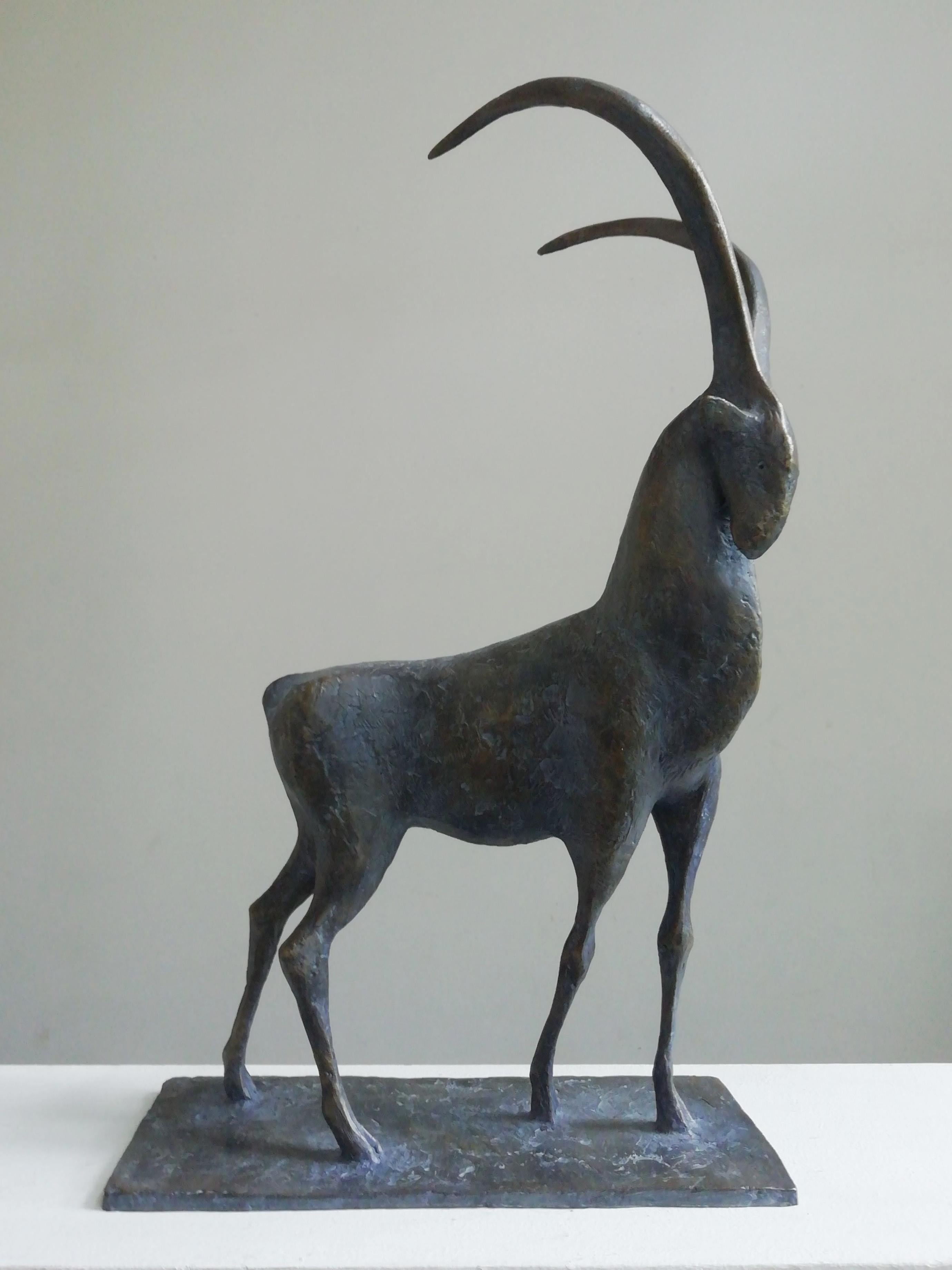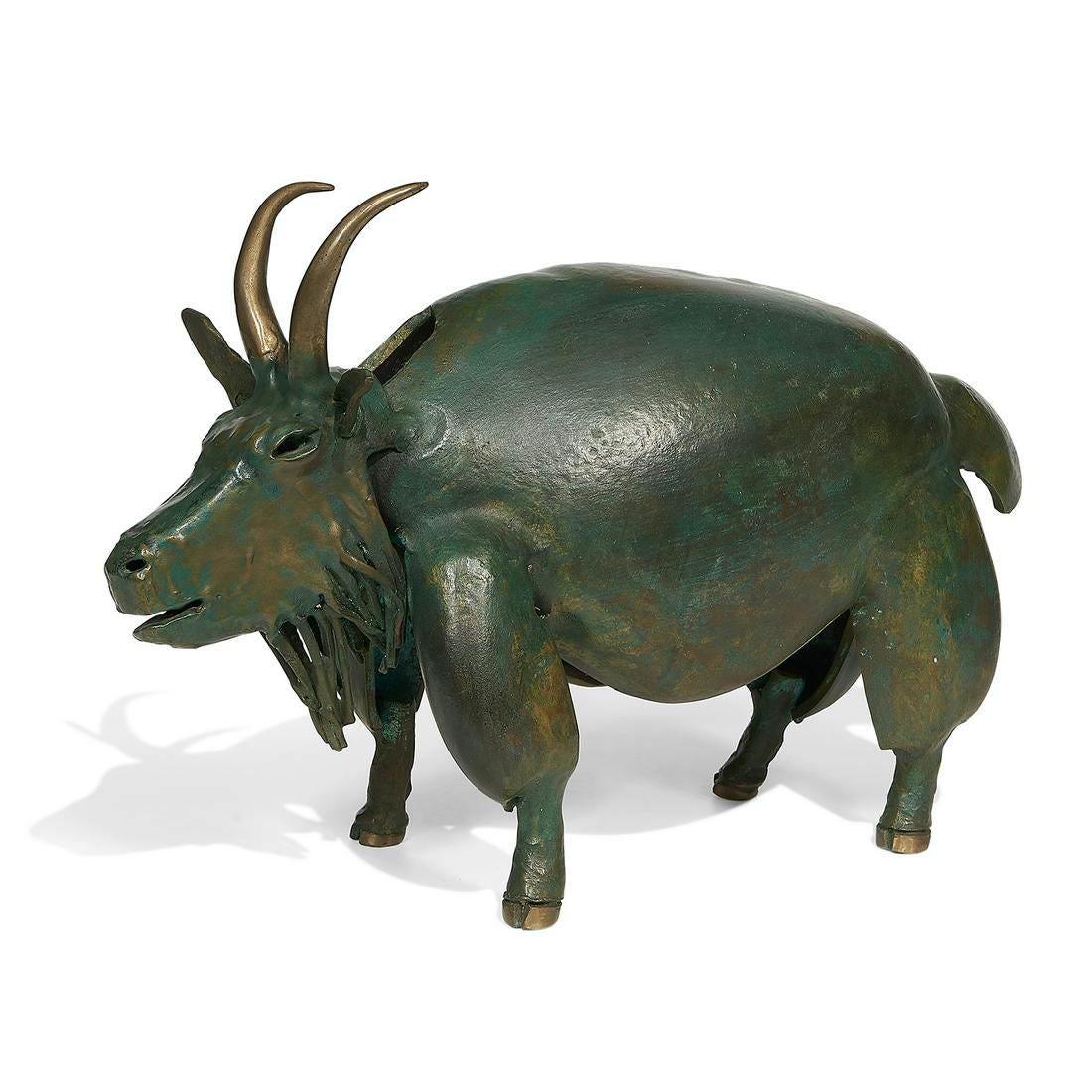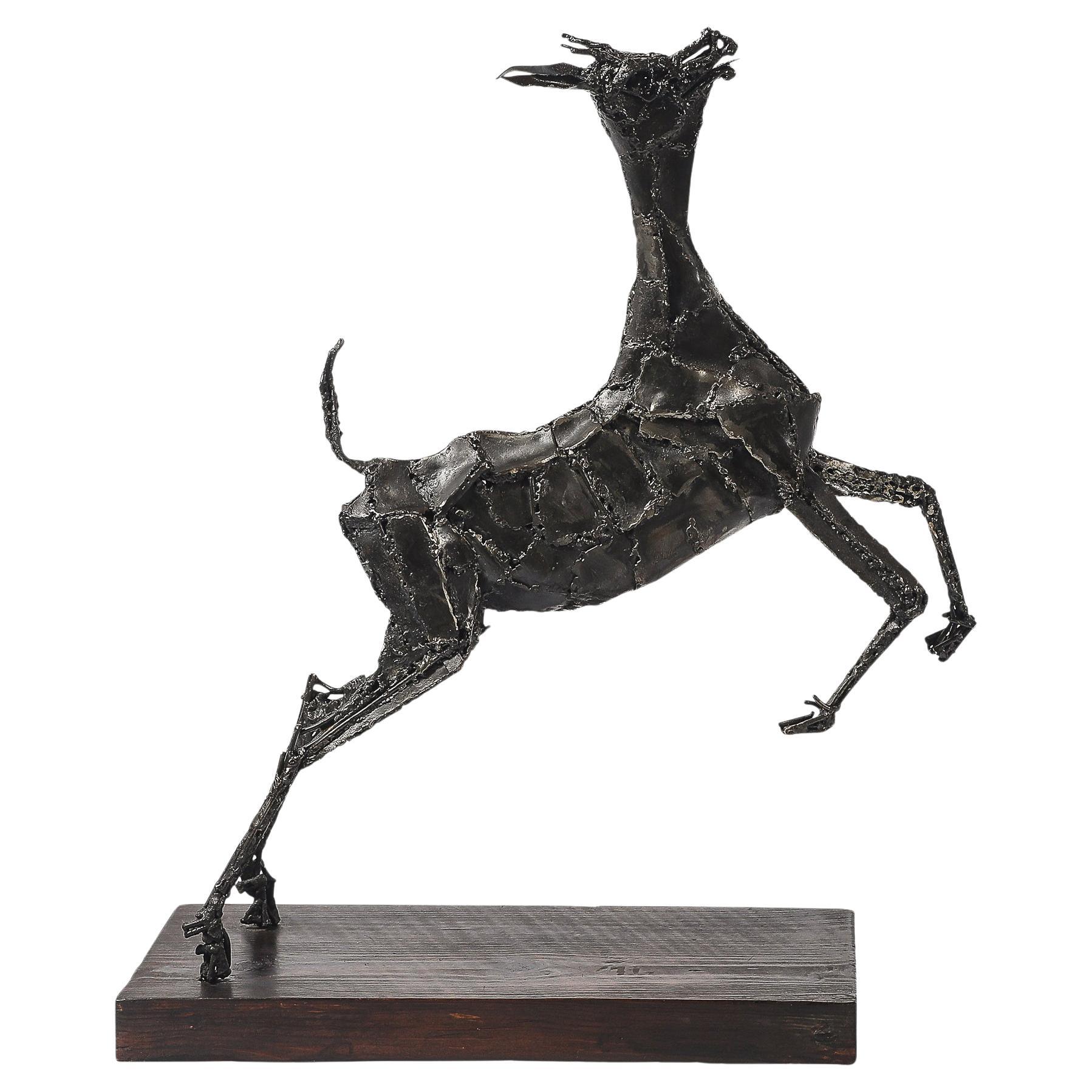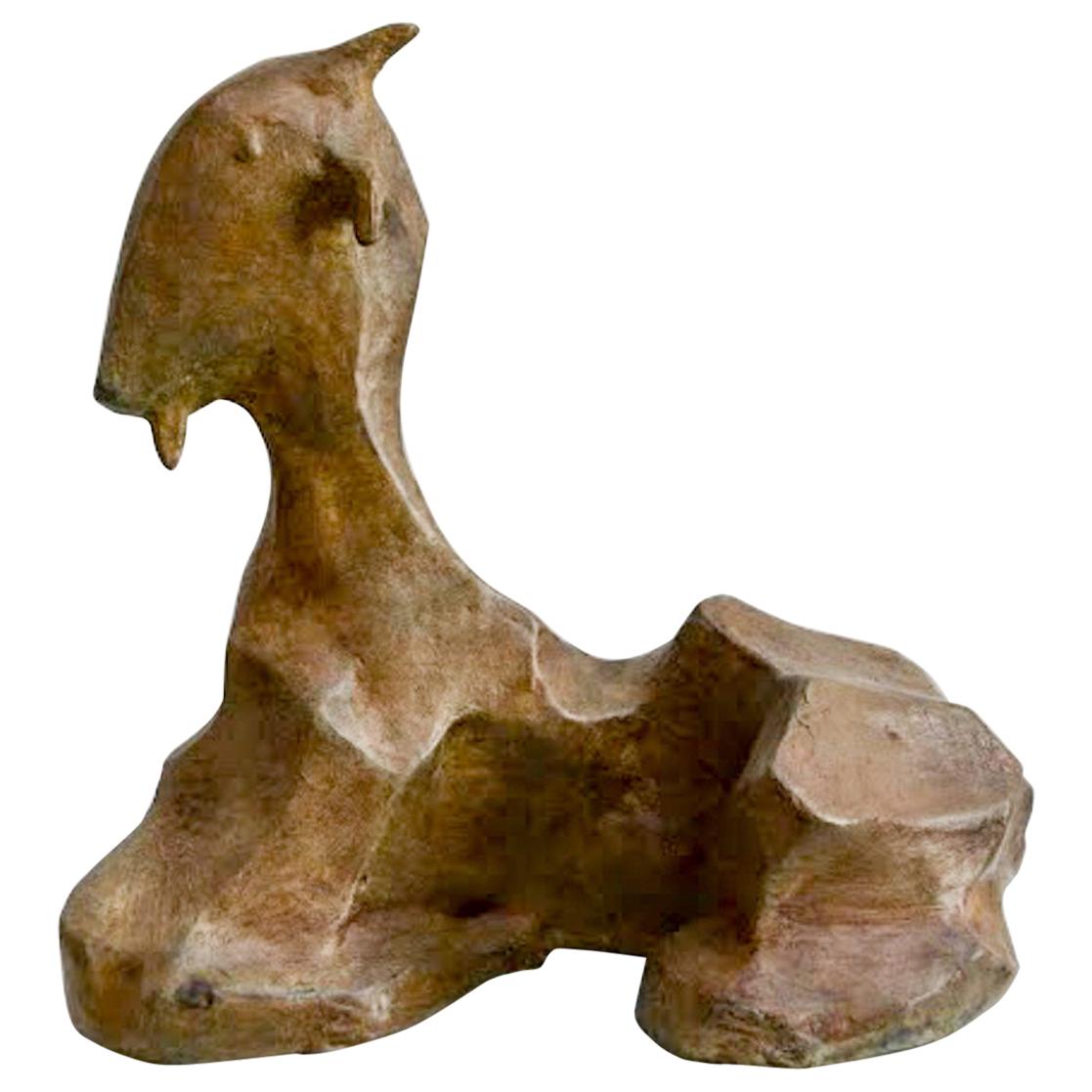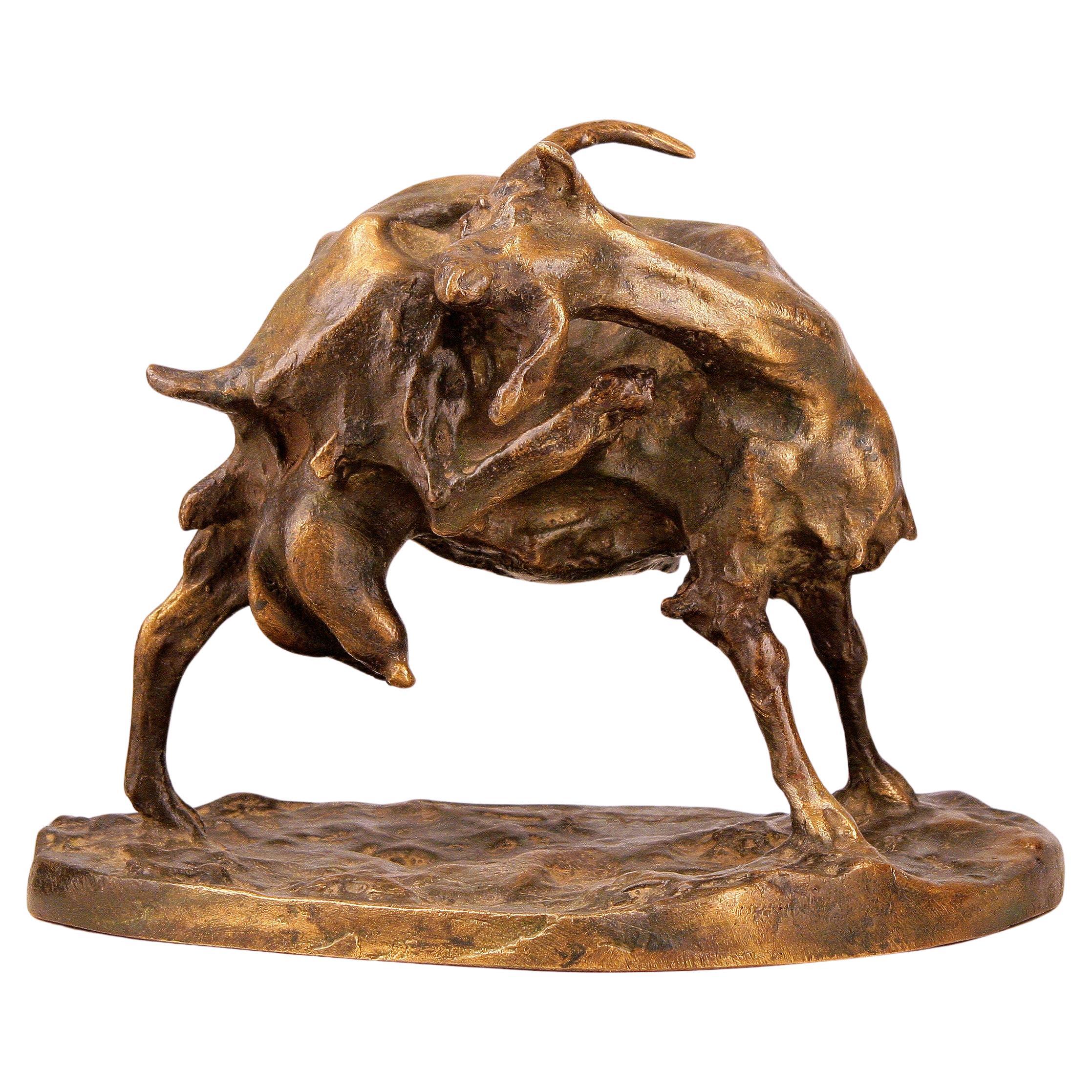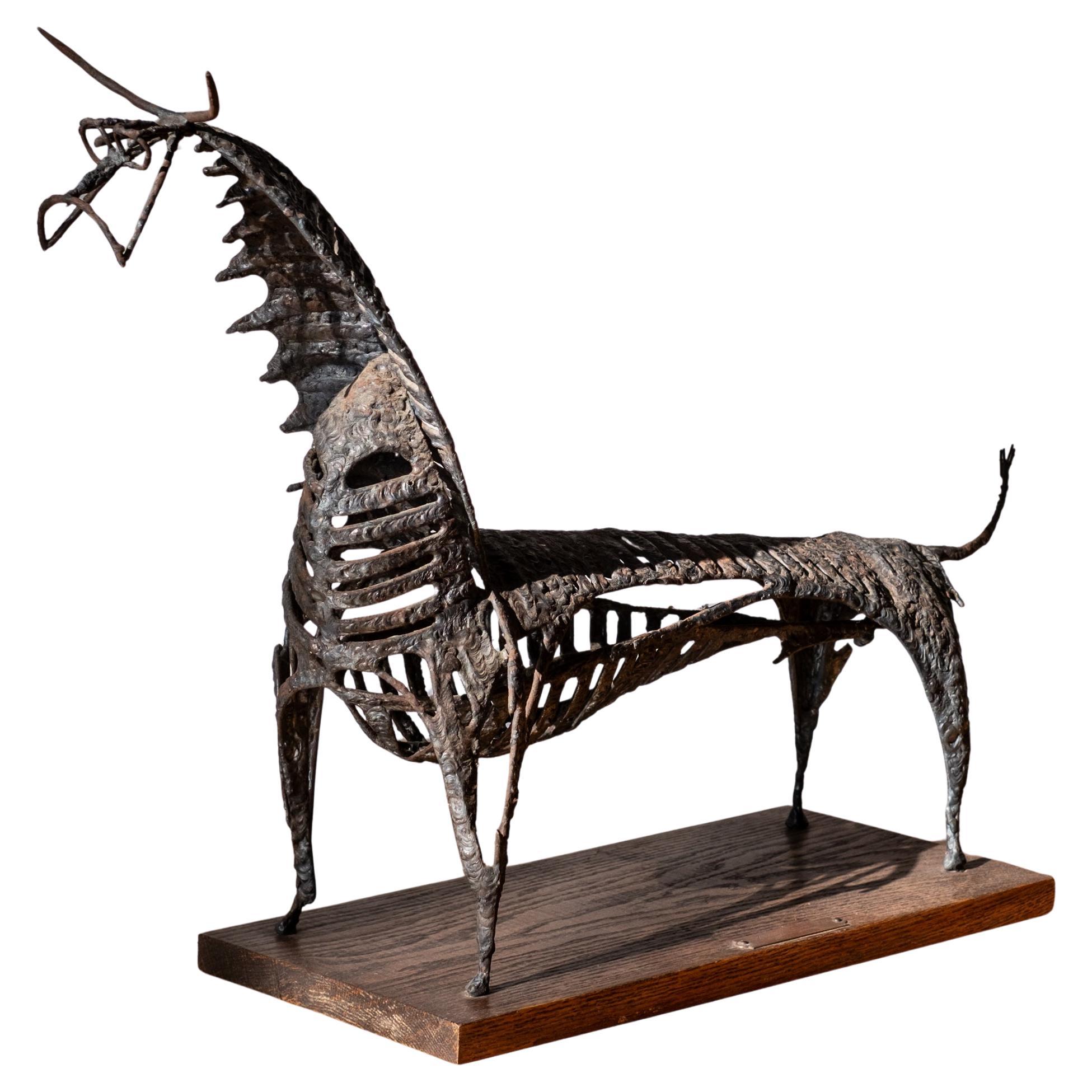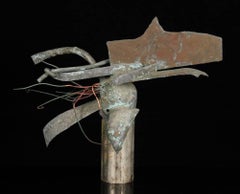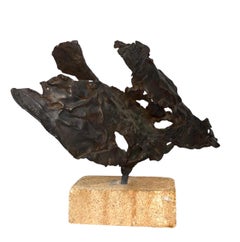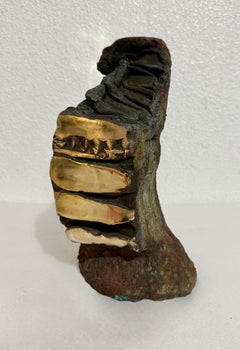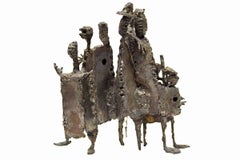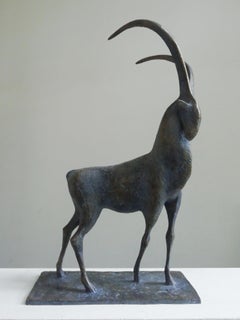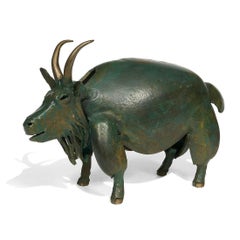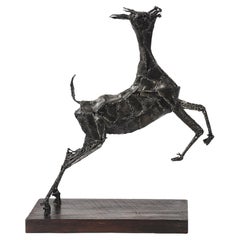Items Similar to Bronze Sculpture Abstract Brutalist Goat or Ram WPA Artist Mounted on Base
Want more images or videos?
Request additional images or videos from the seller
1 of 8
Benedict Michael TattiBronze Sculpture Abstract Brutalist Goat or Ram WPA Artist Mounted on Basec.1950's
c.1950's
$4,500
£3,430.34
€3,918.89
CA$6,332.13
A$6,935.65
CHF 3,651.62
MX$82,774.68
NOK 46,536.63
SEK 42,541.50
DKK 29,284.66
About the Item
Benedict Tatti (1917-1993) worked in New York city as a sculptor, painter, educator, and video artist. He studied stone and wood carving under Louis Slobodkin at the Roerich Museum. He later attended the Leonardo da Vinci School of Art studying under Attilio Piccirelli. In l939 he taught adult classes with the Teachers Project of the WPA and attended the Art Students League for three and a half years on full scholarship. He studied under William Zorach and Ossip Zadkine and later became Zorach’s assistant. Later in his career, he attended the Hans Hofmann School of Fine Arts. During World War II, Tatti served in the United States Army Air Force, where he spent three years assigned to variety of projects. In 1948, Benedict Tatti married Adele Rosenberg in New York City.
Throughout his career, Tatti continuously experimented with various media. From 1952-1963, Tatti executed sculptural models of architectural and consumer products for the industrial designers, Raymond Loewy Associates; later he became a color consultant for the firm. In the 1960s, influenced by the Abstract Expressionists, Tatti turned from carving directly in wood and stone to creating assemblage architecture sculptures, using bronze metal and other industrial materials.
He was included in the important show "Aspects de la Sculpture Americaine", at Galerie Claude Bernard Paris, France, in October 1960 along with Ibram Lassaw, Theodore Roszak, David Smith, Louise Bourgeois, Danese Corey, Dorothy Dehner, Lin Emery, Lily Ente, David Hayes, Louise Nevelson, Tony Rosenthal, Richard Stankiewicz, Sam Szafran and Benedict Tatti. During this period, Tatti spent summers on Monhegan Island in Maine, where he developed his watercolor techniques. In the 1970s, Tatti, with no previous background in video work developed technology for video imaging. He became an associate member of the Kitchen at the Mercer Arts Center exhibiting his video sculptures along with other early innovators of this new art form. He assisted his brother, Alexander Tatti and his nephew, Steven Tatti on the restoration of the Statue of Liberty on Ellis Island. Benedict Tatti received solo and group exhibitions at museums and galleries in the United States and abroad, including the Burr Gallery, Claude Bernard Galleries, ACA Gallery, Puma Gallery, Weyhe Gallery and Metropolitan Museum of Art, under the Artists for Victory Program, Museum of Modern Art, National Gallery of Art, Northeast Gallery, Pennsylvania Academy of the Fine Arts, and the Roko Gallery. Also, Tatti's work was regularly featured in annual exhibitions of several arts organizations: American Society of Contemporary Artists, Annual Avant Garde Festival, Audubon Artists, Brooklyn Society of Artists, and Painters and Sculptors Society of New Jersey. His awards included the National Soldier Art Competition at the National Gallery of Art (1945); Artist-in-Residence, National Center of Experiments TV, San Francisco, California, (1969); and the Creative Artists Public Service (CAPS), (1972). Tatti's artwork is in the permanent collections of the American Numismatic Society, Art Students League, Dumbarton Oaks, Monhegan Museum, Smithsonian Institution, and the Usdan Center for the Creative and Performing Arts.
He won first prize for his sculpture, “Soldier”, in the National Soldier Art Competition, which was exhibited at the National Gallery of Art, Washington, D. C. and the Chicago Art Institute. He continued to direct carve both wood and stone into the decade of the fifties. He also developed his watercolor techniques during summer visits to Monhegan Island, Maine, where many of his friends summered.
- Creator:Benedict Michael Tatti (1917 - 1993, American)
- Creation Year:c.1950's
- Dimensions:Height: 13 in (33.02 cm)Width: 15 in (38.1 cm)Depth: 6 in (15.24 cm)
- Medium:
- Movement & Style:
- Period:
- Condition:good. base has minor wear.
- Gallery Location:Surfside, FL
- Reference Number:1stDibs: LU38215114312
About the Seller
4.9
Platinum Seller
Premium sellers with a 4.7+ rating and 24-hour response times
Established in 1995
1stDibs seller since 2014
1,846 sales on 1stDibs
Typical response time: 1 hour
- ShippingRetrieving quote...Shipping from: Surfside, FL
- Return Policy
More From This Seller
View AllBrutalist Bronze Abstract Modernist Sculpture
Located in Surfside, FL
In the manner of Julio Gonzalez, mixed metal sculpture.
Neo-Dada Abstract Sculpture: Assemblages
Abstract sculpture followed a slightly different course. Rather than focusing on no...
Category
20th Century Abstract Expressionist Abstract Sculptures
Materials
Bronze, Copper
Brutalist Israeli Bronze Abstract Sculpture Wave Form Zvi Aldouby
Located in Surfside, FL
Zvi Yehuda Aldouby (1904 - 1996) was active/lived in Israel. Zvi Aldouby is known for Artist, teaching.
Biography photo for Zvi Jehuda Aldouby
Zvi Yehuda Aldouby (Hirsch Leib Zupnick), sculptor, born 1904, Galicia. Immigrated 1924. Upon aliyah in 1924 he worked in agriculture and construction. 1936-51 studied art and the history of art with Trude Haim, Professor J. Schwartzman, Ds. Schiff, Pinkerfeld, Aviyona, Javetz, and others.
After WWII he worked for the Jewish Agency as an envoy in Italy under the aegis of the UNWRA, on the welfare of the survivors of the Holocaust in the DP Camps. In 1948 in Paris, he evaluated advanced studies in European Art Centers. He was a member of the Israel Painters and Sculptors Association. He was a member of the Artists' Village in Ein Harod from its inception. EIN HAROD About the Museum's Holdings: Israeli art is represented by the works of Reuven Rubin, Zaritzky, Nahum Gutman, Mordecai Ardon, Aharon Kahana, Arie Lubin, Yehiel Shemi, Yosl Bergner and others.
The graphic arts collection contains drawings and graphic works by Camille Pissarro, Modigliani, Jules Pascin, Marc Chagall (almost all of his graphic work), and numerous other artists. The sculpture collection includes works by Jewish sculptors from all over the world including leading Israeli sculptors; Ben Zvi, Lishansky, David Palombo (brutalist), Yehiel Shemi, Aharon Bezalel and Igael Tumarkin (surrealist). Many Jewish sculptors from all parts of the world, beginning with Mark Antokolsky, are represented in the collection. In the sculpture courtyard there are works by Chana Orloff, Jacob Epstein (the works he bequeathed to the Museum), Enrico Glicenstein, Loutchansky, Constant and Indenbaum from Western Europe; Glid from Yugoslavia; William Zorach, Chaim Gross and Minna Harkavy from the United States; and most of the outstanding sculptors of Israel : Zev Ben-Zvi, Lishansky, Ziffer, Rudi Lehmann, Dov Feigin, Moshe Sternschuss, Zvi Aldouby, Yehiel Shemi, Aharon Bezalel, Hava Mehutan, Igael Tumarkin.
Education:
1924-28 Hebrew University, Jerusalem, graduated
1931-37 Teachers' Seminar, Jerusalem, Teacher's Certificate
1938-29 Advanced studies, with Trude Haim
Joseph Schwarzman, School of Art
1948-50 Advanced studies in Italy and France
Teaching
Taught history of art and sculpture Holon
Awards And Prizes
1957 Herman Struck Prize, Artists' Association of Haifa and the North, Haifa Municipality
1963 Dizengoff Prize for Painting and Sculpture, Municipality of Tel Aviv-Jaffa
1964 Medal from Monaco International Exhibition
1965 Prize for the ''Breakthrough into the Negev'' proposal for a monument, Givati Corps, 52nd Brigade
1967 The Histadrut Executive Prize
1991 Worthy Citizen of Tel Aviv Award, Municipality of Tel Aviv-Jaffa
Environmental Sculptures
1961 Levant Fair, Tel Aviv, "A Sculpture in a Garden"
1968 Atlit Youth Club, Bas- Relief- "Davd Playing Before King Saul"
1969 Netivot (Negev), "Yizkor"- Monument memorializing Aliyat Hanoar youngsters from Tunisia who perished in an air crash.
1944 Collective Annual Exhibition by Palestinian Artists
Art Gallery of the ''Habima'' Building, Tel Aviv
Artists: Hermann Struck, Moshe Sternschuss, Arie Reznik, Aaron Priver, Yitzhak Itzhak Danziger, Zvi Aldouby, Menachem Shemi, Moshe Castel, Shmuel Ovadyahu, Yohanan Simon, Marcel Janco.
Group Exhibition - Etched Voices, Yad Vashem, Jerusalem painting...
Category
1950s Abstract Sculptures
Materials
Limestone, Bronze
Enrico Donati Abstract Expressionist Brutalist Bronze Sculpture Surrealist Art
By Enrico Donati
Located in Surfside, FL
Enrico Donati (1909 – 2008)
A Brutalist Bronze Surrealist Sculpture Totem.
With a great patina and both rough and high polished textured bronze.
Signed on side
Dimensions: height ...
Category
20th Century Surrealist Abstract Sculptures
Materials
Bronze
Mid Century Modern Brutalist Welded Expressionist Sculpture
Located in Surfside, FL
In this bronze sculpture the artist (unknown) has welded together a group of figures into a unified piece. These figures take on animal, and human characteristics, which is evident i...
Category
Mid-20th Century Abstract Expressionist Abstract Sculptures
Materials
Metal
Mid Century Modern Brutalist Welded Expressionist Sculpture After Paul Evans
Located in Surfside, FL
In this bronze sculpture the artist (unknown) has welded together a group of totems or monuments into a unified piece. T
Neo-Dada Abstract Sculpture: Assemblages
In contrast, abstra...
Category
Mid-20th Century Abstract Expressionist Abstract Sculptures
Materials
Metal
Large Latin American Modernist Bronze Abstract Cuban Master Roberto Estopinan
By Roberto Estopiñan
Located in Surfside, FL
Roberto Estopinan, Cuban, 1920 - 2015
Dimensions: 24.5" wide x 13" high plus 6" high base.
Roberto Estopiñán (1921–2015) was a Cuban American sculptor known for his sculptures of the human form, including political prisoners. Born in Camaguey, Cuba, he lived in the United States for over fifty years. His works are held by major institutions such as the Museum of Modern Art, the Whitney Museum and the Smithsonian Museum of American Art.
Roberto Gabriel Estopinan, a sculptor, draftsman, and printmaker, was born in Havana, Cuba on March 18, 1921. Estopiñán enrolled at the San Alejandro Academy when he was just 14 years old and became the protegé and studio assistant of the sculptor Juan José Sicre. After graduation he traveled first to Mexico, where he met and befriended Francisco Zuniga, and studied Pre-Columbian sculpture. In 1949 he traveled to Europe, visiting England, France and Italy. In these trips he encountered the sculpture of Henry Moore and Marino Marini, and their humanistic yet formal visions would be influential on Estopinan's work. Estopiñán was a pioneer of direct carvings using wood and of welding techniques in Latin America. Throughout the 1950s, Estopiñán received important prizes at various national exhibitions in Havana. In 1953 he was the only semi-finalist from Latin America at the Tate Gallery's international sculpture competition for a Monument to the Unknown Political Prisoner. In 1961, the artist moved to New York, where he resided until 2002.
Roberto Gabriel Estopiñán a Cuban emigre sculptor who emigrated to exile in the United States not long after Fidel Castro’s revolution in 1959, is considered one of Latin America’s most important 20th-century artists. His work, which includes drawings and prints as well as sculptures in wood and bronze, is in the collections of New York’s Museum of Modern Art, the Smithsonian’s American Art Museum, the Art Institute of Chicago, and the Detroit Institute of Art, among many locations. He is best known for his stark, disturbing renderings of political prisoners, the fruit of his own experiences as a dissident under both Castro and his predecessor, the dictator Fulgencio Batista, and for his representations of the female torso that can remind viewers of both classical statuary and the high-modern, abstractly elongated work of Henry Moore.mHe was born in Havana to a father from Asturias in northwest Spain and a mother of African descent. Estopiñán was something of a prodigy. At the age of fourteen, he won the first prize in drawing at the Centro Asturiano, a regional association for Cubans of Asturian descent. Shortly afterward he received special permission to enter the San Alejandro Academy of Fine Arts in Havana. At the school he was mentored first by its director, the painter Armando Menocal (1863-1941), then by the landscape artist Antonio Rodríguez Morey (1872-1967), and finally by Juan José Sicre (1898-1974), regarded as one of Cuba’s greatest sculptors. Sicre, a professor of sculpture at the Academy, had helped introduce European modernist art to Cuba, and from the 1930s through the 1950s had sculpted monumental figures in Havana of José Martí and other Cuban national heroes that stand to this day. Estopiñán was first Sicre’s student, then his assistant, and, finally, his colleague for the next fifty years. After graduating from San Alejandro in 1942, Estopiñán began simultaneously teaching art at the Ceiba del Agua School for young men, assisting Sicre in public art projects and developing his own artistic vision. He also traveled widely, to Mexico, New York, France, and Italy. From the late 1940s through the 1950s his sculpture evolved from an early neoclassical phase under the influence of Maillol to what he defined as “formalist humanism”: emphasizing the abstract beauty of the shapes he sculpted while not abandoning the human figure as the basis of his work. As the 1950s progressed he chose to carve in native Cuban woods...
Category
20th Century Abstract Figurative Sculptures
Materials
Bronze
You May Also Like
Ibex by Pierre Yermia - Contemporary animal bronze sculpture, mountain goat
By Pierre Yermia
Located in Paris, FR
Ibex is a bronze sculpture by French contemporary artist Pierre Yermia.
Dimensions: 62 × 37 × 16 cm (24.4 × 14.6 × 6.3 in).
The sculpture is signed and numbered, it is part of a lim...
Category
2010s Contemporary Figurative Sculptures
Materials
Bronze
Rocky Mountain Goat, bronze 20th century sculpture of a goat
By John Kearney
Located in Beachwood, OH
John Kearney (American, 1924-2014)
Rocky Mountain Goat, 1991
Bronze
11 x 17 x 6 inches
Born in Omaha, Nebraska, John Kearney studied at the Cranbr...
Category
1990s Figurative Sculptures
Materials
Bronze
Mid-Century Brutalist Welded Bronze Sculpture of a Leaping Goat on Wood Base
Located in New York, NY
This striking Mid-Century Brutalist sculpture of a leaping goat is a masterful example of welded bronze artistry. The dynamic composition captures the energy and grace of the goat mi...
Category
Vintage 1970s American Mid-Century Modern Animal Sculptures
Materials
Bronze
'Goat' Bronze Sculpture
By RinDesign
Located in London, GB
'Goat' bronze sculpture created by Studio Rinat Design, molded and cast in bronze in the lost wax process. The sculpture is available to order in other patinas and in gold finish.
Li...
Category
21st Century and Contemporary British Modern Animal Sculptures
Materials
Bronze
$2,388
Patinated Bronze Early 20th Century Sculpture of Goat by Italian Ernesto Bazzaro
By Ernesto Bazzaro
Located in North Miami, FL
Patinated bronze early 20th century sculpture of goat by italian sculptor Ernesto Bazzaro
By: Ernesto Bazzaro
Material: bronze, copper, metal
Technique: cast, molded, polished, pati...
Category
Early 20th Century Italian Bohemian Animal Sculptures
Materials
Metal, Bronze, Copper
Brutalist Mid Century Modernist Abstract Metal Bull Sculpture by Charles
Located in San Diego, CA
Modernist Mid-Century Modernist abstract metal Bull Sculpture by California Artist Charles Luedtke. Incredible craftsmanship in torch welded steel. This was acquired directly from th...
Category
Vintage 1960s American Mid-Century Modern Abstract Sculptures
Materials
Steel
More Ways To Browse
Mid Century Abstract Bronze Sculpture
Mid Century Bronze 1960s Sculpture
Bronze 1960 Mid Century Modern Sculptures
Wood Sculpture Base
Abstract Mid 20th Century Metal Sculpture
Mid Century Abstract Stone Sculpture
Abstract Wood Carved Mid Century Modern Sculpture
Brutalist Bronze Sculpture Mid Century
Mid Century Brutalist Art
Bronze Ram
Wood Brutalist Sculpture
Ram Sculpture
Goat Sculpture
Brutalist Wood Art
Wpa Sculptures
Bronze Sculpture Goat
Ram Bronze Sculpture
Wood Ram Sculpture
